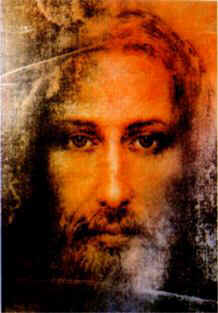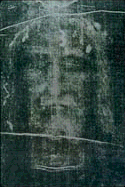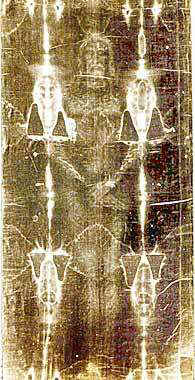Science and the Holy Shroud of Turin
"Then the soldiers, when they had crucified Jesus, took his garments, and made four parts, to every soldier a part; and also his coat: now the coat was without seam, woven from the top throughout. They said therefore among themselves, Let us not rend it, but cast lots for it, whose it shall be: (John 19. 23-24) And after this Joseph of Arimathaea, being a disciple of Jesus, but secretly for fear of the Jews, besought Pilate that he might take away the body of Jesus: and Pilate gave him leave. He came therefore, and took the body of Jesus. And there came also Nicodemus, which at the first came to Jesus by night, and brought a mixture of myrrh and aloes, about an hundred pound weight. Then took they the body of Jesus, and wound it in linen clothes with the spices, as the manner of the Jews is to bury. Now in the place where he was crucified there was a garden; and in the garden was a new sepulchre, wherein was never man yet laid. There laid they Jesus therefore because of the Jews preparation day; for the sepulchre was nigh at hand (John, 19,38-42) Then cometh Simon Peter following him, and went into the sepulchre, and seeth the linen clothes lie, And the napkin, that was about his head, not lying with the linen clothes, but but wrapped together in a place by itself. (John 20, 6-7) The Shroud is a word translated from the Greek word "Sindone" that means "linen cloth". According to Jewish tradition the body of a dead person was wrapped in this sheet and then placed in the sepulcher. Today, when we talk of the "Holy Shroud" we mean the linen sheet that has been kept for centuries in the Chapel of the Shroud in Torino (Italy) and that shows the imprint of a human face and body that is believed to be Jesus' THE CARBON 14 In 1988 a tiny portion of the shroud was concluded to be from the 14th century using radio carbon dating, the long-held scientific method of counting isotopes of carbon atoms. That conclusion made many people think the shroud was not a real relic. Whanger and his colleagues said that the part of the shroud that was tested was contaminated with extraneous materials and life forms, and was not representative of the rest of the cloth, so he concludes that the carbon dating was not accurate for the cloth as a whole. The sample may have been contaminated. The sample came from a water-stained, scorched edge of the Shroud, and carbon could have been added to the cloth, obscuring the true date of its origin. Also, living fungi and bacteria have been found growing inside the fibers, possibly contaminating the sample.
In 1988 a test of dating with the method of Carbon 14 was made. The result was an age between years 1260 and 1390. This test had a great resonance in world-wide mass media, and many belived that the Shroud was a falsification. Nevertheless, there was not the same attention to the later rectifications of scientists that recognized the dissability of the application of this method of dating because the carbon-14 of the Holy Shroud is altered. There is now serious evidence that the samples cut from the Shroud and provided to the laboratories were contaminated. This alteration of carbon 14 must to four main reasons: 1º. By the radiation that recorded the image. This was demonstrated in the Scientific International Congress of Rome by two scientists: Professor Lindner, Technical Chemistry professor in the German University of Karlsrue, and Professor Rinaudo, Nuclear Medicine professor in the French University of Montpellier. 2º By the fire that suffered in the church of Chamberi in 1532, being the Holy Shroud kept in a box of silver. Thus demonstrates Dimitri Koutsenov , Theoretical Physicist in Moscow. The weave was contaminated by gases of the fire. During the fire, the box of silver that hoarded the Shroud was under great temperatures, of several hundreds of degrees, and several drops of melted silver even fell on the linen cloth, that was damaged, although the central image was happily preserved. The Russian scientist has demonstrated that the changes from the fire could cause a misdating of several hundred years. 3º. By the "bio-plastic" coating of live fungi and bacteria that causes serious errors in radiocarbon tests. Fungi and bacterias cover the fibers. It is an investigation of Dr. Leoncio Garza Valdés, microbiologist of San Antonio University in Texas, U.S.A. As a result of the discovery of bio-plastic coatings, many objects from antiquity are being retested. 4º There are adhered to the linen cloth recent elements, that could induce to error when dating the original date from the Sindone, such as microscopic organisms and fungi.  FORENSIC ANALYSIS
FORENSIC ANALYSIS
Pathologist who have examined the Shroud have concluded that it is the image of crucified Man. The Man is dead, in a state of rigor mortis. There are numerous wounds on the body and blood flows from many of these wounds.
Computer processing has shown that the image has three-dimensional properties, something which neither paintings nor standard photographs possess. On it, is 'atomicaly' printed ( a technology that doesn't exist) the complete imprint of a corpse of a man who was beaten and crucified, whose wounds on the shrowd are the same wounds described as pertaining to Jesus.( Same knee & face wounds descriptions, and
side piercing, crown of thorns for proclaiming to be a king, and so forth..., all as described in the new testament.) There is no problem in diagnosing what happened to this individual. The pathology and physiology are unquestionable and represent medical knowledge unknown 150 years ago. This is a 5-foot, 11-inch male Caucasian weighing about 178 pounds. The lesions are as follows: beginning at the head, there are blood flows from numerous puncture wounds on the top and back of the scalp and forehead. The man has been beaten about the face, there is swelling over one cheek, and he undoubtedly has a black eye. His nose tip is abraded, as would occur from a fall, and it appears that the nasal cartilage may have separated from the bone. There is a wound in the left wrist, the right one being covered by the left hand. This is the typical lesion of crucifixion. The classical artistic and legendary portrayal of a crucifixion with nails through the palms of the hands is wrong: the structures in the hand are too fragile to hold the live weight of a man, particularly of this size. Had a Man been crucified with nails in the palms, they would have torn through the bones, muscles, and ligaments, and the victim would have fallen off the cross. 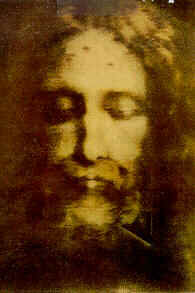
There is a stream of blood down both arms. Here and there, there are blood drips at an angle from the main blood flow in response to gravity. These angles represent the only ones that can occur from the only two positions which can be taken by a body during crucifixion. A momentary 'T' position to breathe, until the pain on the feet becomes too great, and a "Y" position with bent knees, which quickly paralyzes the chest muscles from strain and pain. On the back and on the front there are lesions which appear to be scourge marks. Historians have indicated that Romans used a whip called a flagrum. This whip had two or three thongs, and at their ends there were pieces of metal or bone which look like small dumbbells. These were designed to gouge out flesh. The thongs and metal end-pieces from a Roman flagrum fit precisely into the anterior and posterior scourge lesions on the Body. The victim was whipped from both sides by two men, one of whom was taller than the other, as demonstrated by the angle of the thongs. There is a swelling of both shoulders, with abrasions indicating something heavy and rough had been carried across the Man's shoulders within hours of death. On the right flank, a long, narrow blade of some type entered in an upward direction, pierced the diaphragm, penetrated into the thoracic cavity through the lung into the heart. This was a post-mortem event, because separate components of blood cells and clear serum drained from the lesion. Later, after the Corpse was laid out horizontally and face up on the cloth, blood dribbled out of the side wound and puddled along the small of the back. There is no evidence of either leg being fractured. There is an abrasion of one knee, commensurate with a fall (as is the abraded nose tip); and, finally, a spike had been drive through both feet, and blood had leaked from both wounds onto the cloth. The evidence of a scourged man who was crucified and died from the cardiopulmonary failure typical of crucifixion is clear-cut. One of the most intriguing aspects of the Shroud image is the graphic evidence of the spear wound in Jesus' chest. The Gospel of John states that He was already dead when He was stabbed in the side in order to make sure that he was dead, and that blood and water proceeded from the wound. This mixture is visible on the Shroud. It proceeded from the chest wound, and is actually more visible on the dorsal image, where the blood flowed horizontally across the waist. Physicians agree that the Shroud image of the wound is consistent with the gospel statement that a Roman lance penetrated Jesus' heart. However, the experts have similar but somewhat differing explanations for the presence of the water as well as blood in the flow from the wound. 
One view concerns the pericardium, the sac which surrounds the heart, and which contains a small amount of watery fluid. When the body undergoes great stress, as crucifixion would certainly entail, the amount of fluid increases and the sac expands. The Roman lance would then have passed through Jesus' pericardium and into the right side of His heart, which is filled with blood even after death. As the lance was withdrawn, it would draw out the blood from the heart and the watery fluid from the expanded pericardium. There are a different explanation for the water flow. The severe scourging caused internal hemorrhaging in Jesus' chest, and the pleural cavity filled with blood. The blood settled on the bottom of the chest cavity while a clear liquid was left on top. The Roman lance entered the chest and, upon being withdrawn, released the blood and the water from the chest. Both of these views may be partially correct. The lance could have passed through the pleural cavity, through the pericardium and into the heart. The blood could have come both from the pleural cavity and from the right side of the heart, while the water could have come from both the upper chest cavity and from the pericardium. The most probable thesis is that the lance pierced both the pleural cavity and the right side of the heart. The explanations for the blood and water flow are closely related at several points. All physicians who have examined the question agree that Jesus was already dead when the chest wound was inflicted. The blood and water most probably flowed from both the heart and the chest cavity. Physicians who have examined the Shroud image are unanimous in their belief that the Man was dead when he was placed in the Shroud, and that His death was caused by crucifixion and the tortures that preceded it. They also agree that he was dead when the spear pierced his side. They are not as sure about the exact cause of Jesus' death, but their opinions are quite similar. Most experts hold that Jesus died primarily of asphyxiation, the usual cause of death in crucifixion. According to this view, Jesus died more quickly than most victims because scourging and beating had gravely weakened Him. He was eventually unable to pull himself up on the cross in order to breathe [the "T" position described above], and he asphyxiated in the "down" position [the bent-knee "Y" position] on the cross. In this case, the muscles around his lungs kept him from exhaling and directly caused his death. Complications due to congestive heart failure were likely as well. Most scholars hold that asphyxiation played an important part in Jesus' death. He struggled on the cross to keep breathing. Some scholars hold that he asphyxiated directly when the chest muscles fail to sustain breathing. Others suggest asphyxiation as the blood and fluid also compressed his lungs. But all these scholars agree that the Shroud contains conclusive evidence that Jesus indeed died and that it reveals the general features of His death. Most notable is a piercing wound on one visible wrist, though there are blood flows on both arms that suggest similar wounds to both wrists. There are similar wounds on the feet. The side has been pierced and there is a significant flow of blood and a clear liquid, possibly as a result of fluid accumulation in the chest cavities related to terminal cardio-respiratory failure. About the head are small puncture wounds with rivulets of blood flowing downward and into the hair. One eye seems particularly swollen and the nose seems to have suffered an abrasion. There are abrasions on the nose, on the knees, and across the shoulders. There are the definite images of a traumatic scourging on the back, chest and legs. The triple pattern of dumbbell shape wounds appear to have been made with a Roman flagrum. There are as many as 120 such wounds and it appears that the blows were delivered from both sides and at somewhat different heights, perhaps by two men. There is dirt on the knees, on the tip of the nose, and on the feet. This dirt contains travertine aragonite limestone found in Israel, likely only found in this part of the world. The blood stains on the cloth are human blood, type AB. The stains on the Shroud suggest that there was a separation of blood and serum which happens after the heart stops beating. It is significant to note that the blood stains are not on top of any image. This means that the blood stains pre-existed any image formation. The blood is also very red in appearance. That this is due to the presence of bilirubin, a substance produced when the human body is under severe traumatic stress. The image of the Man on the Shroud is anatomically correct and the differences in the vein and arterial blood flow conform to the proper circulation of blood in the body. The distinctive rivulets of blood flowing from the wrist wounds could only occur if the arms were stretched out approximately 65 degrees to the horizon. The thumbs are not visible as would be the case if nails or spikes were driven though the wrists. They would fold under into the palms of the hands. Asphyxia, as would be caused by crucifixion, is the the most likely cause of death. The Shroud is that it is an image of a dead Man, still in rigor mortis, who was crucified with nails or spikes driven through his wrist and feet after being scourged. His side was pierced and about his head, both in front and in back, there are numerous smaller puncture wounds. We know from history and archeological evidence that the Romans often broke the legs of crucifixion victims. The Man on the Shroud's legs were not broken.
The image presents numerous details of a Roman execution and of the reaction of a human body after this type of execution, completely ignored until a few years ago. The Man in the Shroud was executed in exactly the same way Jesus reportedly was executed. 
THE COINS OVER THE EYES
By the end of century XX were discovered a mark in the right eye that would correspond with a coin type Lepton Simpulum, in circulation between years 29 and 32. 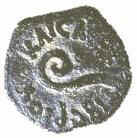
The NASA scientists who analyzed the Sindone in year 1978 discovered that, on the eyelids of the Man recorded in the Sindone, there are small objects that could not identify. Since antiquity, coins have been placed over the eyes of deceased persons to hold eyelids shut.
About 1980, Francis Filas, S.J., of Loyola University in Chicago and Michael Marx, an expert in classical coins, examined the area over the right eye and detected patterns of what appeared to be the letters U CAI (from TIBERIOU CAISARUS) and a lituus design (an auger's staff). Prof. Filas concluded that this was a lituus lepton coin minted by Pontius Pilate between 29 and 32 CE. Over the left eye, Prof. Filas also identified what he believed to be a Julia lepton with a distinctive sheaf of barley design. The Julia lepton was only struck in 29 CE in honor of Tiberius Caesar's wife, Julia. The UCAI problem. Though the lepta (plural of lepton) minted in Palestine were Roman produced coins, the inscription of Tiberius Caesar would have been written in Greek as TIBERIOU KAISAROS. Was the C, where a K was expected, a misspelling? This was a problem that seemed to preclude positive identification until an actual lituus lepton was found with the aberrant spelling. Several have since been found. It is quite possible that coins were placed on the eyelids to keep the Man's eyes closed. This was a common burial practice. This custom to place coins in the eyelids of corpses was practiced by the Jews in century 1. 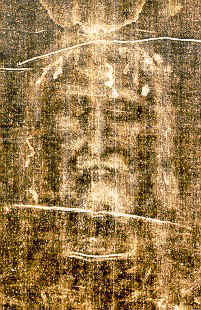
THE FABRIC Now there was a man named Joseph, a member of the Council, a good and upright man, who had not consented to their decision and action. He came from the Judean town of Arimathea and he was waiting for the kingdom of God. Going to Pilate, he asked for Jesus' body. Then he took it down, wrapped it in linen cloth and placed it in a tomb cut in the rock, one in which no one had yet been laid. It was Preparation Day, and the Sabbath was about to begin. Luke 23:50-54 The analysis of the Fabric confirms that it corresponds with existing fabrics 2.000 years ago. It should be stressed that this way of weaving the fabric was ceased using after century I, because manual weaving looms disappeared and they were not used again. One does not preserve in any museum of the world specialized at fabrics, fabrics of this type posteriors at century I. The manual-woven Fabric with the shape of fish spine, measured 436 X 110 cm. It is a fabric woven in the old Damask style; a "fish spine", in forty-five degrees, laid out of two in top and two downwards. The transverse wire passes thus under three verticals to emerge in the fourth, which requires a weaving loom of four pedals. One found only some cotton fibres but nor the most minimal remainder of hair of animal none. The absence of hair of animal is explained by the prohibition of the Jew's law that in a weaving loom one mixes vegetable and animal fibres. In Europe it was necessary to wait until century XIII so that one makes fabrics similar to the Sindone. The fact of finding some cotton fibres was used to some researchers to specify their origin, because in Europe one did not cultivate cotton, although indeed which was made in Palestine. In the Code of the Jewish Law, one reports the habit of burial in the section "Laws of the duel", being one of his indications that a person carried out by the Government must be buried in only one shroud. THE IMAGE The controversial Shroud of Turin is a 4 1/2 meter, 7.62 centimeter long linen cloth that bears a remarkably detailed image of a bearded, long-haired Man, with numerous lacerations over his body. Tradition, dating back to at least 1354 A.D., has it that the fabric, with its brownish, stain-like shadings, is the burial shroud of Jesus Christ. Enshrined in the northern Italian city of Turin since 1578, the shroud has inspired widespread curiosity, especially since the first photographs of it taken in 1898 showed the markings to be a "negative" rather than a "positive" image. The resulting "picture" resembles rubbings made from base-relief art works. The image is very faint and composed of discolored lengths of fibers that have been chemically altered (dehydrated, oxidized and conjugated). The image is actually a 3-D encoded chart of the front and back of a Man that also happens to have the important characteristics of a photographic negative. The series of tests revealed any pigment, no trace of painting. But it establishes the presence of blood to the site of the wounds. The image was surface, its colouring did not penetrate in wire; the image touched only top fibres of the screen of the Shroud on a depth of about 40 microns. What excludes any impregnation from liquids and consequently any technique of impregnation for the image. This one is made up of "yellow fibrillae". Colouring is the product of a dehydration of cellulose of unknown origin making think of a reddening kind caused by a heat source. No "directional layout" (blow of brush) was identified on the Shroud. With the obviousness, this image did not have an artistic invoice. It was a "negative photographic" perfect, very detailed. It is necessary to move away of more than 2 meters of the Shroud to be able to perceive a readable image and to identify it as being a silhouette of a body of Man and it is with 5 meters that certain details appear. The image printed on fabric is in fact a negative and it will have been necessary to await the invention of photography at XIX century to discover it. The support was woven according to a method specific to the areas close to Jerusalem, one contemporary time of Jesus-Christ, and contains some traces: of a cotton species specific to Palestine, on a weaving loom type of those used at the previous century of the birth of Jesus... (no cotton species not pushing in Europe) and however, in conformity with the Mosaic Law which prohibits the port of a clothing containing
of fibres coming at the same time from the animal world and the vegetable world. The origin and the mode of impression of the colouring which one could rather call pigmentation are not identifiable. Traces of haemoglobin are however detected there but the fibres, subjected to a microscopic examination, are not "turned russet" (to employ a running term reflectrometry) but superficially, without impregnation or even traces of surface wrenching. The apparent reddening of the fabric constituting the image, principal visua lcharacteristic, does not have affected fibres of wire but only and a selective way, of the fibrillae, measurable in a few tens of microns. The print of the Image does not exist under these tasks of blood as if this blood had protected the fabric! 
No trace of dyes of mineral or organic origin (or even of liquid apart from blood and its natural components revealed by the phenomenon of the capillarity and gravity: the image is surface, like those usually used by the painters, could not be found. The scientific examinations proved that the intensity of the shades is in concordance partial or total with dehydration of fibres of surface of the wire which constitute the fabric. The image of the shroud is the result of a polarizing vertical projection, that excludes any form from heating radiation because heat is exerted in an omnidirectional way. Any painted work made up of hand of man, i.e. manually achieved, lets appear after examination and image processing, a direction of execution with points or zones of starting, movements or directional traces which is named "preferential space frequencies". None of these frequencies are detected by the computer, that prove that it acts of another procedure that that of the hand of a man and this fact is worth to him to
be a archeiropoietic work! The mechanism of formation of this image is thus "isotropic", without directional effect, excluding a manual execution inevitably, therefore of human origin. The postcolorisation of digitized images makes it possible to reveal additional details. The image does not cross the fabric on side to side. Only one face of the Shroud is printed with the frontal and dorsal image of a Man whipped, in "rigor mortis" and died by crucifixion. The image is not painted, not printed, neither it exists remainders of pigments, neither dyes, neither silks of brush, neither the broad outline of painting, nor added organic material. The bloodstains are made up of hemoglobine. 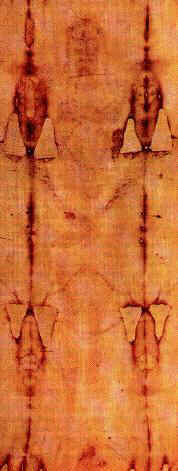
The Man of the Sindone is a thin and very detailed image of an adult Man with semi-long hair and a beard; 5' 10" tall, weighing about 175 pounds, constitution strong, muscular; long hands and feet; a Semitic face with the traces left by a complete hat of spines and not a crown; and a series of details which made it possible to reinforce the biblical history of the crucifixion. The image coincides with the description of the inert body of Jesus of Nazaret after having suffered the crucifixion. The evangiles speak about a fabric in which with haste was surrounded Jesus after his death - Good Friday - not to break with the Jewish sabbatical rest. The Jews wrapped the corpses with bindings, as in Lazarus. But with Christ they did not have time, because He died in the three hours of the afternoon and was necessary to finish the burial before the night, because the feastday with total prohibition of any work started then. As Nicodemus and Joseph of Arimathea had to go to require authorization of Pilate to take along the Corpse, to seek the instruments and to take down the Lord of the cross, the afternoon finished and quickly had to bury Him by covering the Corpse with the Shroud. This is why after Saturday, were going the women to finish the burial. The Sindone shows the torment of a young Man, with particular characteristics of the Jewish ethnic group. Blood corresponds to group AB, the most frequent between Hebrews. It acts of a Man who suffered hematidrosis (sweat of blood), great blows in the knees and the back. In the image one appreciates a minimum of 120 blows with a whip of three cords finished in steel balls. The face presents great blows too. It was crowned by a hat of spines, which 33 openings are appreciated. Could be counted in total more than 600 wounds in all the body. All were produced in life, except for a great one in the right side, which has an elliptic form of the same diameter as a Roman lance; and it arrived at the right auricule of the heart. He was crucifixed with nails which crossed the headstocks (not hands); the feet were crossed together by only one nail. The doctors who analyzed the fabric deduced that He suffers strong heart pains, oppression, and very high fever, while dying finally from asphyxiation, not having already forces to rise and breathe. One tried to reproduce the image, but the tests with human corpses, incandescent moulds and various substances result different images. The specialists conclude that the efigie is caused by a species of radiation of unknown origin. The image is into negative, but the blood which soaked the fabric is into positive. The image of the human Figure must be read as reflected in a mirror: what is seen on the right is really on its left and vice versa. The image of Holy Shroud is negative photographic printed in the fabric, but has two very particular characteristics compared to any other negative: it is three-dimensional and there is not unidirectionnelity. Holy Shroud is only three-dimensional "photography". The intensity of the images is inversely proportional to the distance which separates in each point the fabric from the corpse "photographed". The result showed that the latent image was completely three-dimensional, and that there were not lines nor directionnelity in the drawing. It is important to underline the non-existence of directionnelity. To understand this it is necessary to explain as functions a photographic machine. The principle is that of the dark room: we have a room completely closed in one of which walls we open a small opening by which it penetrates the light. An object located out of the room would be reflected, reversed, in the wall opposed to the opening. This one is the base of
the photographic machines. In these images there is the directionnelity, i.e., all the image is formed starting from the rays of light which come from one point: the luminous rays which enter by the opening of the wall. It is not thus with the Sindone. There is not any focal point with to which the image converges. The light which impregnated the Holy Shroud comes from all the surface of the Body. At most near was the fabric with the Body, all the more it intensely burned by the radiation which suddenly appeared of the Body, by giving him its characteristic three-dimensionality. An ancient or medieval artist would have needed to produce a technically accurate elevation with varying monochrome shades. Detail is so fine as to include scourge marks, abrasions, floral images and, possibly, the imprints of coins. It was necessary to await the invention of the computer and software dedicated to the space adventure, with the discovery of Bill Mottern in 1976 on a "VP8 analyzer", of this three-dimensionality which makes it possible to reveal after a scanning of the surface of the linen, a representation in 3d of the unit of the image. What means that the distance between the skin of the torture victim and the surface of the linen, apart
from the impregnated parts of blood, was taken into account and was recorded without the knowledge of the simple first visual approach. This three-dimensionality does not exist, of course, on a photograph of the type of that which general public is able to draw with the classical cameras, so sophisticated they are. The study also confirmed the effect of distance of the image. The definition of the density of color was in connection with the distance between the fabric and the Body. The Sindone was studied by a legion of scientists, and research continues. The VP-8 is an apparatus intended to turn into to research on the orography of planets on the various sets of photographs obtained by the space Viking satellites that sailed around the planet Mars. The result of the analysis of the VP-8 revealed that the image reflected in Síndone was the equivalent on the three-dimensional surface of a human
body. And something not less surprising: the image was concretized uniformly in the Sindone by a species of unknown radiation, which slightly burned in a uniform way the totality of the fabric, this shown that it was not the direct contact with the body what produced the image, but a radiation which emanated from it. 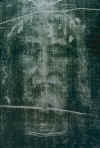
THE POLLENS
Parts of flowers and other plants were placed in the Shroud, leaving grains of pollens and marks in the Fabric. The analysis of grains indicated that they came from species that could be found only in the months of March and April in the region of Jerusalem. The pollen of a plant, a species of thistle named Gundelia Tourneffortii, it was specially abundant in the Fabric, and an image of the plant was identified near the image of the shoulder of the Man. This plant is growing only in the near East. It is possible that this one was the species of the Jesus' crown of thorns. The shroud has some pollen from flowers that only come together in one place: the Jerusalem-Hebron area. The flowers blossom sometime between the months of March and May, the time when Christ was crucified. The flowers placed next to the shroud bloom only an hour a day, so they were picked sometime between 3 and 4 p.m. before being placed next to the Body. Christ is believed to have died late in the day, so His Body would have been prepared shortly after. Analysis of the grains and the images identified the flowers as coming from species that could be found only in the months of March and April in the Jerusalem region.The pollen of one plant, a thistle called Gundelia tournefortii, was especially abundant on the cloth, and an image of the plant was identified near the image of the Man's shoulder. Two pollen grains of this species were also found on another ancient fabric, called the Sudarium of Oviedo, which many believe to be the burial face cloth of Jesus. A first-century origin for the face cloth has been documented, the scientists here said, and it has been in the Cathedral of Oviedo in Spain since the eighth century. 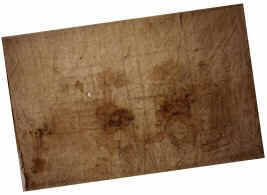
Both the Sudarium and the Shroud appear to carry type AB blood stains, and the stains are in a similar pattern; with the same type of pollen grains. The pollen association and the similarities in the blood stains in the two cloths provide clear evidence that the shroud originated before the eighth century. Several endemic samples of Judaea pollens of century I were also discovered. As well as several of Turkey, France and Italy. Places in which historical testimonies exist on the presence of the Shroud. The last investigations demonstrate that the more abundant pollen in the linen cloth is the same one that is conserved in the sedimentary layers of 2000 years ago in the Genezareth lake, in Palestine. The analysis under the optical microscope and the electron microscope of the separated dust in twelve points of the Linen cloth revealed the presence of pollen of 49 species. Seventeen of these species have an ample area of diffusion, Mediterranean or European, that does not allow conclusions on the precise place of contamination, in France or Italy, in which the Sindone was exposed outdoors in several places, in the last five centuries. They have been identified, in addition, two groups of species that do not exist absolutely in Europe: 29 plants of the near East, thirteen of which they grow in sandy or salty desert places in Palestine, and a group of plants of steppes of Anatolia. These pollens says us that the Sindone has been exposed outdoors in the past in Palestine (Jerusalem) in Constantinopla - today Istambul- and Anatolia, in addition to the stays known in France and Italy. Even plants leave important traces. On the Shroud we find signs of wounds made by thorns, traces of aloe, myrrh and other oils used to preserve bodies. The cloth contains also many kinds of pollens, typical of the Palestinian region. (Jerusalem) 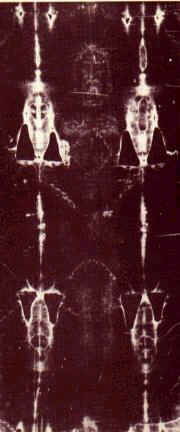
THE RESURRECTION So Peter and the other disciple started for the tomb. Both were running, but the other disciple outran Peter and reached the tomb first. He bent over and looked in at the strips of linen lying there but did not go in. Then Simon Peter, who was behind him, arrived and went into the tomb. He saw the strips of linen lying there, as well as the burial cloth that had been around Jesus' head. The cloth was folded up by itself, separate from the linen. Finally the other disciple, who had reached the tomb first, also went inside. He saw and believed. John 20:3-7
The image of the Shroud is not painted, because there is no painting between thread and thread. In addition, the threads are colored because they are burned. The image is recorded to fire by an instantaneous radiation. A very intense and very brief radiation, that only burned the most external part of fibers of the Shroud. This is deduced of the fact that the threads are not carbonized, but superficially burned, and by the penetration of the burn it is possible to measure the fraction of second that lasted the radiation. The general opinion is that this radiation took place at the moment of the resurrection. Jesus revived, as they affirm Scriptures. No corpse had not before left its recorded image to fire in the linen cloth that covered it, and either returned to happen a similar fact later. One is a unique phenomenon in history. The shrouds of corpses have spots of blood, sweat, all type of rest produced by the decomposition of the dead meat. But no has never left its recorded image to fire in the linen cloth that covers it. Christ, recorded His image in the Holy Shroud when He revived: there is no another explanation. Another surprising fact also exists. The muscles of the back on which the Body rested do not appear flattened, as the weight of the Body would have to happen when supporting on the ground. According sindonology, the Body was in levitation during the resurrection. Yes, exactly before taking place the intense flash of radiation that impregnated the linen cloth with the image of the Corpse, this one rose over the ground and the Soul returned to incarnate in the Body suspended in the air, being caused a great irradiation of energy and heat. Everything indicates that at the moment to take place the radiation, the Body was weightless, in levitation, and for that reason they were not flattened dorsal muscles Another surprising phenomenon is that the Body did not corrupt, because in the linen cloth does not appear no own spot of the decomposition of the Corpse. And, the blood spots indicate that the Body was not separated of the linen cloth, because if it was fluid blood, the edges of the spots would not appear so clear, and if it was dry blood, the blood spots would be deteriorated, and it is not thus. Of this fact it seems to be deduced that the blood tracks that are in Holy Shroud only have been able to leave them a "non-material" or "spiritualized" Body. So, the Body, before "disappearing" was in levitation, and it was "spiritualized" and was generated the mysterious energy of light and heat that caused the three-dimensional negative image. |
THE HISTORY OF THE HOLY SHROUD OF TURIN
| Principal dates relative to the study of the Shroud | |
| Probably the 7th April 30, or perhaps the 3rd April 33 | Crucifixion of Jesus : "Then the soldiers, when they had crucified Jesus, took his garments, and made four parts, to every soldier a part; and also his coat: now the coat was without seam, woven from the top throughout. They said therefore among themselves, Let us not rend it, but cast lots for it, whose it shall be: (John 19. 23-24 And after this Joseph of Ar-im-a-thae-a, being a disciple of Jesus, but secretly for fear of the Jews, besought Pilate that he might take away the body of Jesus: and Pilate gave him leave. He came therefore, and took the body of Jesus. And there came also Nic-o-de-mus, which at the first came to Jesus by night, and brought a mixture of myrrh and aloes, about an hundred pound weight. Then took they the body of Jesus, and wound it in linen clothes with the spices, as the manner of the Jews is to bury. Now in the place where he was crucified there was a garden; and in the garden was a new sepulchre, wherein was never man yet laid. There laid they Jesus therefore because of the Jews preparation day; for the sepulchre was nigh at hand (John, 19, 38-42 Then cometh Simon Peter following him, and went into the sepulchre, and seeth the linen clothes lie, And the napkin, that was about his head, not lying with the linen clothes, but but wrapped together in a place by itself. (John 20, 6-7) |
| ~ 57 | Ma'nu VI inherits the throne of Edessa. Return to paganism, and persecution of the Christians |
| ~ 326 | Helena, mother of the Roman emperor Constantine the Great, (born at Trier in 265, died at Nicomedia in 327), goes to Palestine to find the relics of Jesus. She is reported to have discovered the nails of the Passion, the Cross, and the tunic that she donates to the town of Trier. The narrative of her quest, is written by Eusebius of Caesarea (265-340) in his book 'Ecclesiastical History' |
| 330 | Constantine founds the Roman Empire of the East and of Constantinople. |
| 476 | In 476, Barbarians take Rome. Constantinople is the capital of the Roman Empire. |
| 525 | Flooding of the Daisan, a tributary of the Euphrates, floods the city of Edessa. This flood is mentioned in the writings of Procopeus of Caesarea. In the course of the reconstruction work at Edessa, a cloth is discovered which had been hidden above one of the gates of the town. It shows the face of a man The emperor Justinian of Constantinople orders the cathedral of Sainte Sophie at Edessa built as a home for this image |
| 594 | Evagrius Scholasticus, writes his ecclesiastical history in which he mentions the image of Edessa as "created by God, and not produced by the hands of man". He dates this discovery at 544AD |
| 632 - 642 | Invasion of the middle east by Arabs. Edessa is taken in 639. Christianity is tolerated. The Cathedral of Saint Sophie is preserved, as well as the image of Edessa |
| 673 - 677 | First siege of Constantinople by the Arabs |
| ~ 692 | In Constantinople, Justinian II mints a coin with the effigy of Christ Pantocrator |
| 718 | Second siege of Constantinople. At the same time the Muslims invade the south of Spain, and the Sudarium is carried to Oviedo in the Kingdom of Asturias (Northern Spain) for safe keeping |
| 723 - 842 | Acts of violence by the Byzantian and Muslim iconoclasts |
| ~ 800 | Irene, the Empress of Constantinople, gives to Charlemagne, the tunic of Christ. Charlemagne gives this for safe keeping to his daughter Theodrade, a nun at the Abbey of Argenteuil. It is hidden and would be rediscovered in 1156 |
| 943 - 944 | Siege of Edessa by the Emperor of Byzantium. The image of Edessa is given to him in exchange for his lifting the siege, together with the payment of a large sum of money, and the liberation of Muslim prisoners The Mandylion, the name given by the Byzantians to the image of Edessa, leaves for Samosate and then Constantinople |
| 964 | The Mandylion arrives at Constantinople in August. It will be conserved in the Pharos Chapel, in the Boucoleon Palace |
| 1146 | The Turks take Edessa. The Cathedral of Sainte Sophie is destroyed. |
| ~ 1150 | Writing of the Codex Pray, which contains several miniatures (small paintings) representing the Passion. One of them shows the holy women coming to the tomb after the resurrection. On it can be seen a representation of the abandoned Shroud with marks corresponding to the first set of burn marks that can be seen today on the Shroud of Turin. |
| 1156 | Discovery, in the Church of the Monastery of the Benedictines at Argenteuil, of a tunic stained with blood. This tunic known under the name of Holy Tunic of Argenteuil could well be the seamless tunic that Christ wore at his Crucifixion, and which the Roman soldiers drew lots for. In effect the blood stains are in a pattern relatively similar to that of the stains appearing on the Shroud, and the blood group of these stains is the same as that of the Shroud A+. |
| 1196 | Rediscovered in the Cathedral at Trier (Treves), in old burial chamber, a tunic known as the Holy Tunic of Treves which was said to have been given to the town in the year 325AD by Saint Helena, mother of the Roman emperor Constantine the Great. It may be the outer garment worn by Christ |
| 1204 | The capture and sacking of Constantinople by the Francs of the fourth Crusade. The 12th April, the disappearance of the Mandylion. |
| ~ 1205 | The Holy Shroud is probably at Athens |
| 1248 | The Crown of Thorns is transferred to the Holy Chapel, that Saint Louis had built for it |
| ~ 1350 | First display of the Holy Shroud at Lirey (Champagne, France) |
| 1353 | The knight, Chevalier Geoffrey I de Charny, obtains from the French King, Jean le Bon, a grant to found the Collegiate Church at Lirey |
| 1354 | The Holy Shroud is entrusted to the Collegiate Church at Lirey |
| 1353 | Pope Innocent IV grants indulgences to pilgrims visiting the Collegiate at Lirey |
| 1356 | Battle of Poitiers in France -- French fight against the English, Welsh and Gascons at Nouaille wood. Sept 18th, attempt at negotiations between 11 nobles, (5 were English, whilst the 6 French included the archbishop of Sens and Geoffrey de Charny). Geofrey de Charny proposed a solution, a duel between 100 of the best knights on each side, an echo of the famous battle of the Thirty in Brittany in 1351, but the Duke of Warwick rejected this. The next day, Geoffrey I de Charny was killed on the field of battle. He was the bearer of the French standard, the oriflamme, and was killed defending the French King. His body was later transferred to Paris. (see, Edward, by Barber, 1978. pp 137-148). Geoffrey's widow, Jeanne de Vergy, petitions the King and the subsidies are continued in favour of her son Geoffrey II de Charny |
| 1356 | The Bishop of Troyes (Champagne, France), Henri de Poitiers, sends a letter of congratulations to Geoffrey II de Charny, on the 28th May. |
| 1357 | Twelve Bishops allow indulgences for pilgrims visiting Lirey |
| 1389 | Geoffroy II de Charny petitions the Pope to be allowed to put the Shroud on show. He obtains permission |
| 1389 | Pierre d'Arcis, Bishop of Troyes, writes a memorandum stating that the Shroud of Lirey is a fake (a painting). He asks that it not be displayed any more. |
| 1390 | Clement VII, The first Pope in Avignon (this was during the the Great Schism), orders Pierre d'Arcis to silence, under pain of excommunication. |
| 1398 | Death of Geoffroy II de Charny, on the 22 May. |
| 1400 | The daughter of Geoffrey II de Charny, Marguerite de Charny, marries Jean de Beaufremont who will be killed at the battle of Azincourt in 1415. In 1418 Marguerite de Charny marries again, to Humbert de Villersexel, seigneur de Saint Hippolyte sur le Doubs. |
| 1418 | The Shroud is given to Humbert de Villersexel by the Canons of Lirey. It will be conserved in the chateau de Monfort, near Montbard, then transferred to Saint Hippolyte sur le Doubs, in the Chapelle des Buessarts. |
| 1438 | Death of Humbert de Villersexel ; the canons of Lirey want to recover the Shroud. Marguarite de Charny refuses. The case is carried before the parliament of Dole (May 1443), then to the Court of Besancon (July 1447). Both decide in favour of Marguarite de Charny. The canons refuse to accept this judgment, and ask for the excommunication of Marguarite de Charny. In 1459 they abandon their claim in return for financial compensation. The quarrel had lasted 21 years ! |
| 1449 | Holy Shroud is displayed at Chimay (Principality of Liege) |
| 1452 | Holy Shroud is displayed at the Chateau de Germolles (near Macon) |
| 1453 | The Holy Shroud is transferred to Duke Louis de Savoie by Marguerite de Charny, and moved to Chambery |
| 1494 | The Holy Shroud is exhibited at Vercelli on Good Friday |
| 1503 | Great display in Bourg-en-Bresse |
| 1506 | Holy Chapel of the Holy Shroud in Chambery, and creation of a liturgic Festival of the Shroud on the 4 May by Pope Jules II |
| 1509 | Marguerite of Austria donates a new silver reliquary, that the Shroud will be kept in |
| 1516 | Francois I comes to Chambery 15 June 1516 to venerate the Shroud after the Victory of Marignan (1515) |
| 1532 | Fire in the Holy Chapel at Chambery during the night of 3 to 4 December ; The Holy Shroud is damaged by the fire, and by the water used to fight the fire. |
| 1534 | Authentication of the Shroud after being repaired by the Clarisses of Chambery |
| 1535 | War of Charles V against Francois I who invades Savoie. The Holy Shroud is transferred to Vercelli (Piedmont), and displayed at Turin on the 4th May |
| 1536 | The Shroud is exhibited in Milan |
| 1537 | The Shroud is exhibited in Nice where it stays until 1543 |
| 1549 | The Shroud is kept in treasury of the Cathedral Saint Eusebio at Vercelli |
| 1553 | French troops sack Vercelli 18th Nov. The Shroud is saved by a canon who hides it in his house |
| 1561 | The Shroud rests briefly at Annecy, then is returned to the Holy Chapel at Chambery |
| 1578 | 14th of September : the Holy Shroud arrives to stay permanently in Turin. It is venerated by , among others, Saint Charles Borromee (1578), Saint Francois de Sales (1613), Sainte Jeanne de Chantal (1639), Pius VII (1804), etc. |
| 1670 | The Congregation of Indulgences accords a full indulgence to all who make a pilgrimage to the Holy Shroud "for the meditation on the Passion, and in particular on the death and entombment of Christ |
| 1694 | The Holy Shroud enters the Chapelle Royale of the Cathedral of Turin (1 June), and is stored in the sanctuary designed specially by Guarino Guarini, where it is still to be found. It is fixed on a new black lining made by the Bienheureux Sebastian Valfre who also added several patches where the repairs by the Clarisses had been insufficient |
| 1868 | Princess Clotilde of Savoie, sews a new lining of red silk onto the back of the Shroud |
| 1898 | First photo of the Holy Shroud by Secundo Pia and the discovery that the Shroud is a photo negative. |
| 1902 | Publication of the first scientific study "The Shroud of Christ" by Paul Vignon. A professor of comparative anatomy at the Sorbonne, Yves Delage, an agnostic, concludes that the Shroud is authentic |
| 1931 | The photographer Giuseppe Enrie takes new photos (of excellent quality) of the Shroud |
| 1935 | Publication by Doctor Pierre Barbet of "The Five Wounds of Christ", then, in 1949, "The Passion according to a Surgeon" |
| 1969 | A commission of scientific experts is authorised to examine the Shroud. New photos are taken by Giovanni-Battista Judica-Cordiglia, this time in colour, and under the illumination of a Wood lamp. |
| 1972 | 1st Oct : Criminal attempt by an arsonist to burn the Shroud. The Shroud is spared. |
| 1973 | Samples from the Shroud are taken by Max Frei in an attempt to study the pollens, and by other scientists to study the blood stains |
| 1978 | Scientific study by STURP |
| 1983 | The Holy Shroud is bequeathed to the Pope by the Royal Family of Savoie |
| 1988 | Carbon 14 dating indicates that the Shroud dates between 1260 et 1390. |
| 1989 | Scientific Symposium of Paris, and Creation of CIELT ; Major faults in the Carbon 14 dating process are revealed |
| 1993 | Scientific Symposium of Rome ; confirmation by the scientific community of the Shroud's authenticity |
| 1997 | Criminal fire at the Chapelle Royale de Turin ; The Shroud 'miraculously' escapes destruction |
| 1997 | Scientific Symposium of Nice : Confirmation that the formation of the image on the Turin Shroud is not the work of man |
